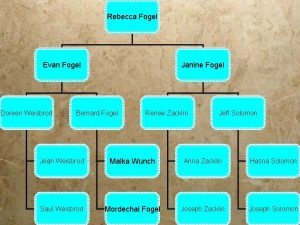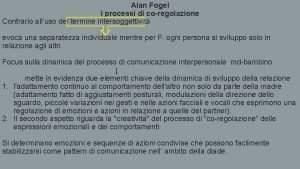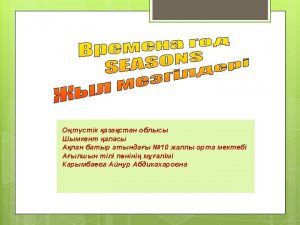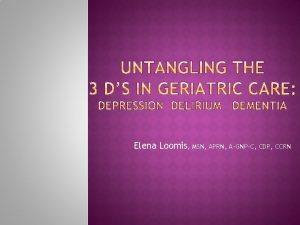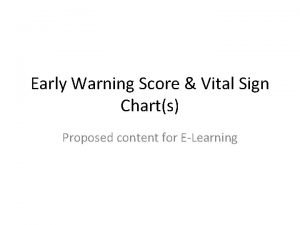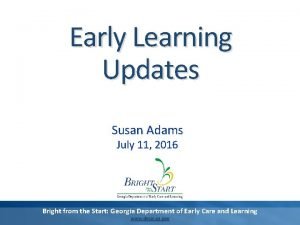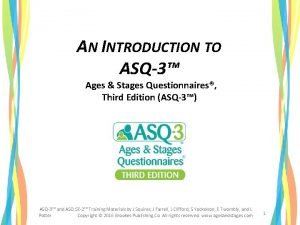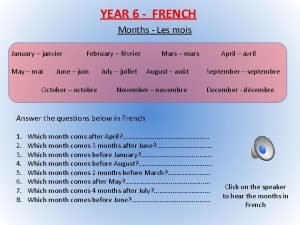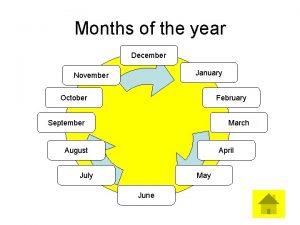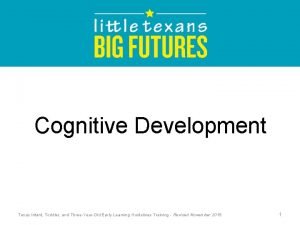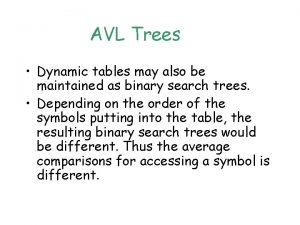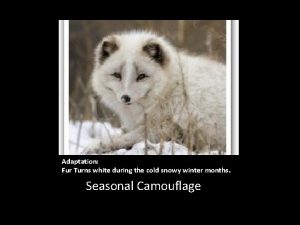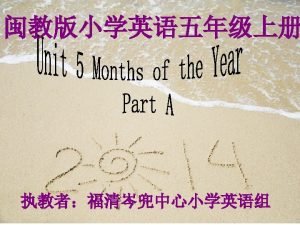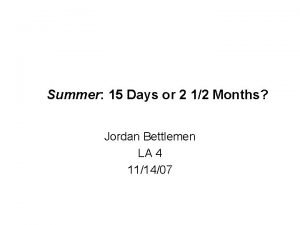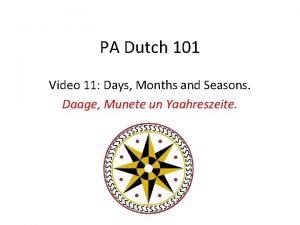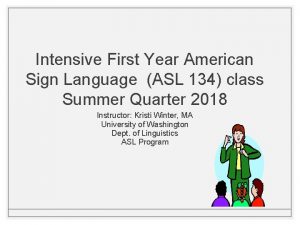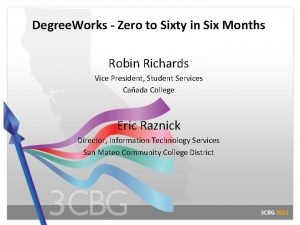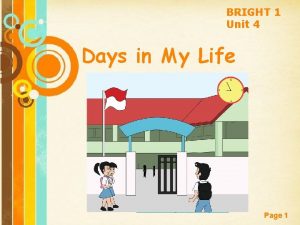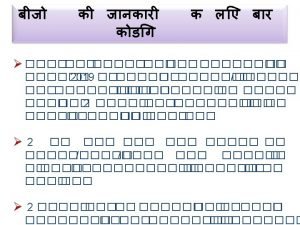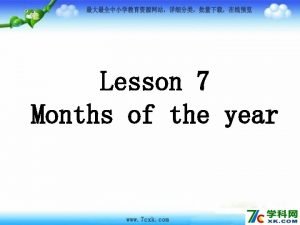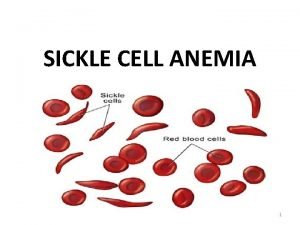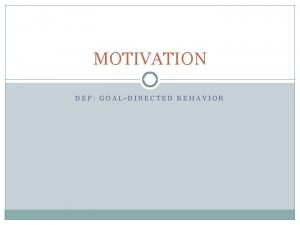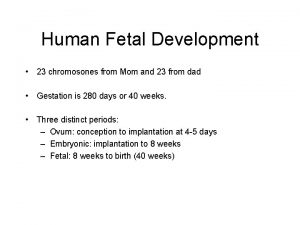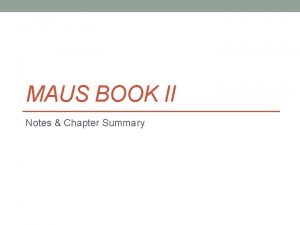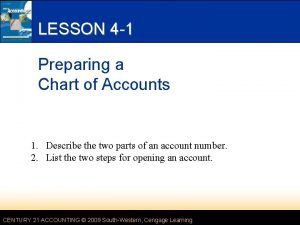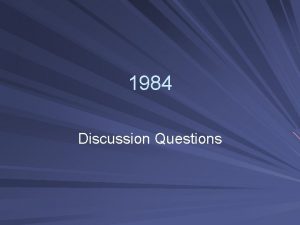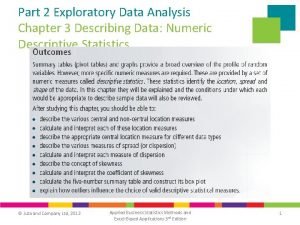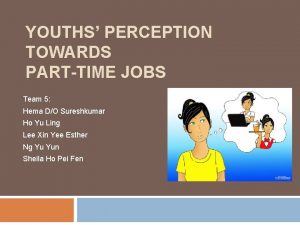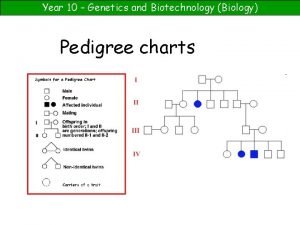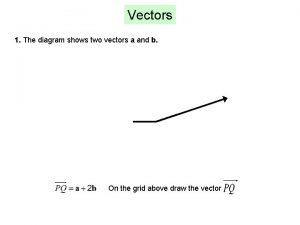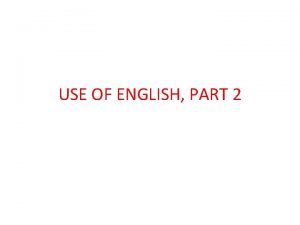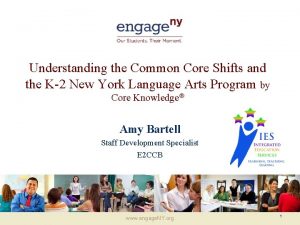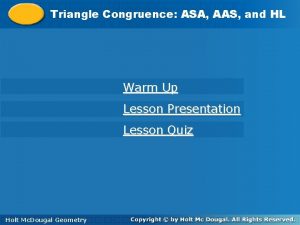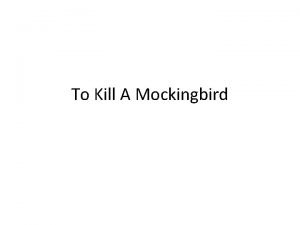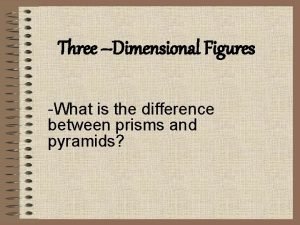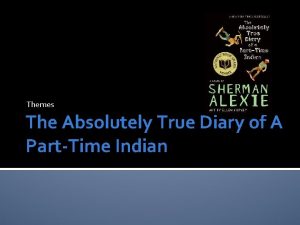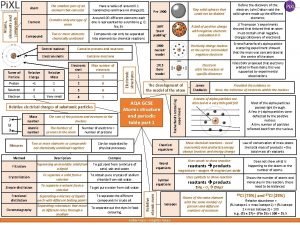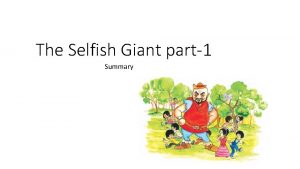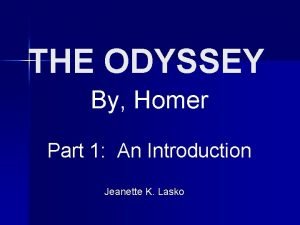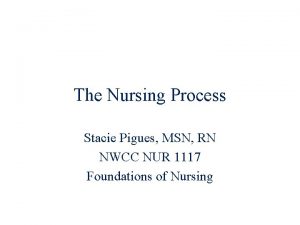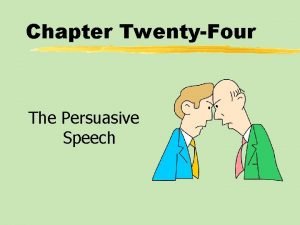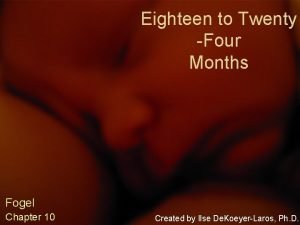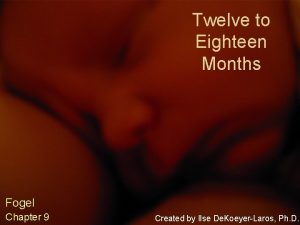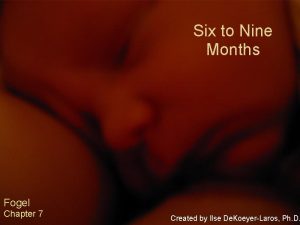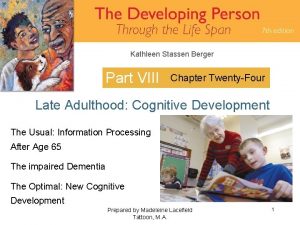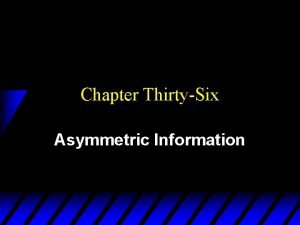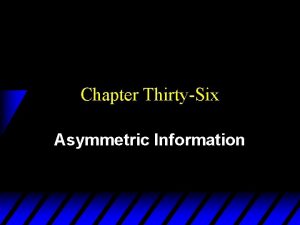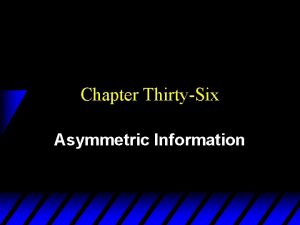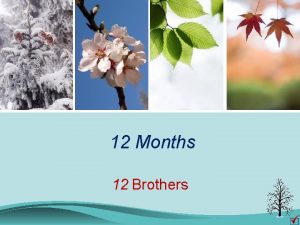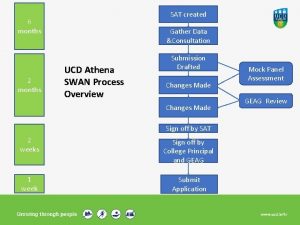TwentyFour to ThirtySix Months Fogel Chapter 11 Part









































































































- Slides: 105

Twenty-Four to Thirty-Six Months Fogel Chapter 11 – Part 1 Created by Ilse De. Koeyer-Laros, Ph. D.

Overview Chapter 11 • • Motor & Cognitive Development Emotional Development Social and Language Development Family and Society Experiential Exercises Co-regulating with Baby

Introduction The infancy period is not over until late in the 3 rd year of life, when children – genuinely engage in linguistic and cooperative interactions with peers, siblings, & parents – use productive grammatical speech – have an awareness of themselves as boys or girls

Motor & Cognitive Development Motor Development • By age 3, most children have developed their adult hand preference • Early drawings – by age 3, children are drawing squiggles and making simple shapes on paper – once children begin to draw shapes, they prefer simple ones, such as circles and rectangles

Motor & Cognitive Development Motor Development During the 2 nd and 3 rd years, children develop exercise play – physically vigorous playful movement (e. g. , running, chasing, climbing) – may or may not be social – accounts for about 7– 14% of behavior in day care settings for 3 -year-olds – on average, boys have a higher activity level than girls

Motor & Cognitive Development Motor Development • Benefits of exercise play – increases fitness, endurance, strength, & skill – may reduce fat & increase the ability of the body to regulate temperature – may enhance cognitive ability • Both boys & girls need exercise play for the healthy development of body & mind Picture from: www. greenheartsinc. org/Our_Services. html

Motor & Cognitive Development Motor Development By age 3, most children have learned how to use the toilet – there are no differences in age of toilet learning depending upon whether a child attended child care outside the home – girls tend to be trained earlier (on average, at about 35 months) than boys (at 39 months)

Motor & Cognitive Development Thinking Grounded in Action 2 -year-olds learn to flexibly combine actions & persist until they reach a goal – in one study, 2 -year-olds were able to perform all the actions in a particular sequence • e. g. , build a house, clean a blackboard, dress a doll – only 2 -year-olds were able to correct their errors & persist until the task was completed

Motor & Cognitive Development Thinking Grounded in Action Attention span also increases • TV watching increases markedly at 30 months, about the same time these other changes are happening • the more children comprehend of TV programs, the longer they will watch Picture from www. momisteaching. com/. . . /uploads/weemote. jpg

Motor & Cognitive Development Thinking Grounded in Action Self-produced action appears to affect cognition • In one study, 3 -year-olds were taken into a children’s area in a natural history museum – some of the children were allowed to explore the area on their own – others were led through it by an adult – those who went on their own had a more accurate spatial cognition of the layout of the area than those who were led

Motor & Cognitive Development Language Aids both Thought & Action Piaget: • both action & language develop because of increases in cognitive abilities such as logical thinking – a 3 -year-old cannot answer the following question because of an inability to understand the logical chain of comparisons • Bill is older than Tom is older than Steve • Who is older, Bill or Steve?

Motor & Cognitive Development Language Aids both Thought & Action • Alternative explanation: this error may be due to a linguistic problem – e. g. , difficulty understanding differences between similar words with different endings, such as old and older • Research suggests that children comprehend something like this: – “Bill is old; Tom is not old. Tom is old; Steve is not old. ” – this seems like contradictory information

Motor & Cognitive Development Language Aids both Thought & Action Around 30 months, children • have developed thought – an internalization of their social-linguistic regulatory system • begin to talk to themselves – private speech – the use of language to regulate one’s own behavior without the intention of a social communication Picture from: raisingchildren. net. au/. . . /todd_girlplaying. jpg

Motor & Cognitive Development Language Aids both Thought & Action Private speech occurs when the child: – talks about an intended action (“I put that there”) – describes ongoing action (“Banging it”) – makes a statement to an inanimate object (“Get out of my way, chair!”) – asks a question and then answers it (“Why are you crying, dolly? Because I’m sad”)

Motor & Cognitive Development Pretending & the World of Make-Believe • Piaget: – complex action sequences result from developments in the cognitive realm • Vygotsky: – they result from language & social experience – complex action sequences have their origins in earlier social interactions

Motor & Cognitive Development Pretending & the World of Make-Believe Imaginative pretend play begins at age 2 • inventing whole new situations in make-believe • allows the self to emerge victorious in case of failure or save face in case of embarrassment Pretend role play also begins – acting out roles of mother, father, or other important figures in their lives Picture from: http: //www. toddler-activities-at-home. com/toddler-imaginary-play. html

Motor & Cognitive Development Pretending & the World of Make-Believe In one study, adults pretended to “pour” or “spill” some pretend tea – after 28 months, children can participate in these pretend episodes – they will “drink” from the cup and help “clean up” the “spilled” tea – their language shows they understand the situation is make-believe and not real

Motor & Cognitive Development Pretending & the World of Make-Believe Pretending is also manifested as dreaming, which children can talk about for the first time – often about experiences the child has had, physical changes such as toileting, and strong emotions – dreams other than nightmares may fulfill a wish, or may take a painful event and finish it off with a happy ending Pictures from: http: //www. preschoolerstoday. com/resources/articles/lightsout. htm

Motor & Cognitive Development Pretending & the World of Make-Believe • Children no longer have to be content with what actually happens – they can make up a better outcome as they play • However, 3 -year-olds are never sure about the limits of this newfound ability – for example, children fear their own imaginary monsters Picture from: notjustcute. files. wordpress. com/. . . /dscn 0678. jpg

Motor & Cognitive Development Pretending & the World of Make-Believe Patterns of individual difference cut across play, language, motor development, and problem-solving behavior • Patterners are concerned with object properties, shape, and form • Dramatists are more involved with storytelling, imagination, and social interaction Picture from: http: //www. juniormagazine. co. uk/development__your_toddler

Motor & Cognitive Development Pretending & the World of Make-Believe 2 -year-olds were offered 16 items & asked to put the items that were alike together – the patterners grouped objects according to their external forms, shapes, and colors – the dramatists grouped the objects by making a story out of them, such as a person in a house made of blocks

Motor & Cognitive Development The Emergence of the Categorical Self Around the 3 rd birthday, children develop the categorical self – the ability to identify their own membership in conceptual categories For example, – “I am a boy” – “I am a sister” – “I am not a baby”

Motor & Cognitive Development Autobiographical memory • Autobiographical memory – the ability to remember experiences verbally – serves to create a sense of one’s life history • More detailed when – mothers elaborate more on children’s stories – children have more advanced verbal skills – children use more mental state words like “thinking, ” “knowing, ” and “remembering”

Motor & Cognitive Development Autobiographical Memory The ability to talk about a past situation depends on verbal skills at the time of the event – children who had a traumatic injury around age 2 could recall the situation verbally up to 2 years later – children who were injured before 18 months showed participatory memories but no verbal recall • one boy had to be tightly wrapped in a blanket at 16 months, to keep him from moving during the stitching • at 34 months, he still refused to be wrapped in a smock when getting his hair cut

Motor & Cognitive Development Participatory Memories Infantile amnesia is primarily a verbal amnesia • if an incident occurs before age 2, participatory memories remain but are largely unconscious (expressed nonverbally but not verbally) • individuals may have participatory memories of early infancy that persist for long periods in the form of nonverbal patterns of action

Motor & Cognitive Development Participatory Memories Traumatic memories may be particularly likely to persist in the form of nonverbal, unconscious participatory memories – these will persist longer if the conditions that created the memories persist and continue to be reenacted – the amygdala alters its cellular structure with trauma leaving the person vulnerable to perceive fear even in relatively benign situations – the hippocampus – necessary for verbal recall – is bypassed in traumatic situations and in infancy

Motor & Cognitive Development The Emergence of the Categorical Self Therapeutic interventions that lead to increases in health allow traumas to be relived safely and then transformed into verbal memories – for instance, play therapy with children – there is controversy over whether such memories can be falsely implanted Picture from: www. storefront. org/vertical/Sites/%7 B 87 DB 415 F. .

Motor & Cognitive Development Gender Identity • Gender identity – the affiliation with being either male or female – early in the 3 rd year, children begin to notice sex differences in behavior and appearance & to show early signs of sexual behavior • Gender labeling – when the child can identify self or other as male or female – begins at about 18 months

Motor & Cognitive Development Gender Identity Up until age 3, children do not understand that these labels reflect enduring characteristics – 2 -year-olds do not understand that a boy will always grow up to be a man – they believe that gender might be changed by changing one’s appearance or dress – they may actively discourage each other from playing with opposite sex peers or opposite gender–typed toys

Motor & Cognitive Development Gender Identity Gender labeling is related to verbal ability, sex of the child, and parents’ emotional reactions to gender-typed toys • more advanced with higher verbal intelligence • boys begin gender labeling & stereotyping earlier than girls • earlier gender labeling if parents have strong reactions Picture from: www. adventures-in-motherhood. com

Motor & Cognitive Development Gender Identity Parental influence over the child’s choice of toys • few parents explicitly instruct their children in the genderappropriate choice or use of toys • stereotypes are communicated by emotional reactions to the children’s choice of toys – parents react less to toy choices that are not gender related & to opposite-gender choices Picture from: www. delaneyfamily. info

Motor & Cognitive Development Gender Identity Other parental contributions to gender identity • discouraging aggression & encouraging prosocial behavior in girls • encouraging responsibility in boys • dressing children in gender-appropriate ways • talking in general about gender and gender roles

Motor & Cognitive Development Communication about Emotions Sex differences in emotional communication • girls talk more spontaneously & earlier about their emotions than boys • parents are more likely to create a shared emotional state with their daughters • parents are more likely to provide a way to resolve daughters’ emotions interpersonally Picture from: www. bridges 4 kids. org/lead-articles. html

Motor & Cognitive Development Communication about Emotions Parents tend to encourage sons to resolve the situation on their own – for example, parents are more likely to encourage sons to retaliate when angry

Motor & Cognitive Development Communication about Emotions Talking about emotions • children of this age can talk about their feelings and label emotional & physiological states • they can talk about future and past emotions, and can discuss the causes & consequences of emotions • they can also talk about others’ emotions

Motor & Cognitive Development Communication about Emotions • By 28 months, most children have extensive emotion vocabularies – for positive emotions (happy, fun, good time, funny, like, love, feel better, proud) – and negative ones (sad, scared, mad, yucky, messy, feel bad) • 6 to 12 months later they begin to talk about their own and others’ thoughts (know, think)

Motor & Cognitive Development Empathy • Children of this age also appear to have a sense of empathy toward others – 2 -year-olds are visibly affected by the emotions of others • In one study, – children expressed concern for their mother, sought her reassurance & tried to comfort her when an experimenter acted angry with her

Motor & Cognitive Development Empathy • 2 -year-olds show “concerned attention” toward others who are in distress – they try to help & to elicit help from bystanders – on average, girls do this more than boys • Children show more empathy with a peer’s distress if it was the child him- or herself that caused the distress

Motor & Cognitive Development Empathy Children of mothers with severe depression show more caring behavior than children of non-depressed mothers – perhaps because they had to prematurely attend to the emotional states of others in order to get attention – they may become disconnected from their own feelings in an attempt to protect their parent from undue emotional arousal

Motor & Cognitive Development Understanding Emotions Children who score high on understanding others’ emotions are likely to come from families in which – there is frequent talk about (causes of) feelings – children have an opportunity to observe parents talking with siblings about their feelings and behavior – children are encouraged to cooperate with their siblings during coordinated play – there is a secure attachment with the mother

Motor & Cognitive Development Understanding Emotions Temperament: • children who are either inhibited or overly active are less likely to show understanding of others’ feelings • they may require a more directive style of parental teaching in order to understand others’ emotions

Motor & Cognitive Development Awareness of self-other relationships Children of this age can • talk about sharing activity with others – “We went down by the pool” • distinguish themselves as part of a relationship – “No one was holding my hand” • metacommunicate about their interpersonal relationships with others – “He wanted to play with me”

Motor & Cognitive Development Awareness of self-other relationships Understanding of others • 3 -year-olds can use motherese when talking to a baby & can describe the kinds of things you might do to take care of a baby • when asked to show a picture to another person, 3 -year-olds turned the picture around to face that person • when they knew that the parent was unaware of an object’s location, they were more likely to gesture toward the object

Motor & Cognitive Development Awareness of self-other relationships • Does this mean that 3 -year-olds have a theory of mind – an understanding that other people have psychological states, which may be different from their own? • No, because – children can copy the parent’s motherese, or just describe what others do for a baby – 2 -year-olds often try to comfort adults with blankets, bottles, etc. (they may be trying to calm their own upset by stopping the crying of the adult)

Motor & Cognitive Development Awareness of self-other relationships Evidence for a rudimentary theory of mind comes from studies of the development of the ability to deceive others – in one study, children • “not only slyly lied and disingenuously misled, but they did so with what often amounted to disarming delight in leading others astray” – to create a false belief, you have to have a theory of mind; that is, you have to assume that others are capable of holding some beliefs

Motor & Cognitive Development Awareness of self-other relationships • To have a genuine theory of mind, children need the following – self-awareness – the capacity for pretending – the ability to distinguish reality from pretending • Most 2 -year-olds have both selfawareness & the ability to pretend Picture from: www. juniormagazine. co. uk/. . . /5. html

Motor & Cognitive Development Awareness of self-other relationships • However, 3 -year-olds lack the ability to separate pretend from reality – until children can do this, they will see others as mere extensions of their own desires • A greater feeling of certainty does not emerge until the age of 4 years, when children solidify a theory of mind – an appreciation of the feelings and desires of others as independent from their own

Emotional Development During the 3 rd year, toddlers become more like children when participating in social relationships with others – they have an increasingly sophisticated repertory of emotional forms of communication Picture from: www. stronghealth. com/services/childrens/Patient. Care/rheumatology/

Emotional Development Positive Emotion • Infants show different types of smiles – Duchenne smiles: more likely with peekaboo games – play smiles: with tickling games • 3 -year-olds have different types of laughs – comment, chuckle, rhythmical, and squeal laughs – each is related to a specific type of communicative situation Picture from: www. stcuthbertscare. org. uk/localauthorities. html

Emotional Development Negative Emotions By the 3 rd year, children increasingly regulate their emotion expression depending upon the situation – more likely to show negative emotions when with their parents – more likely to show sadness when they have their parent’s attention Picture from: www. babyminestore. com/art_crying. html

Emotional Development Anger Physical aggression • higher between 24 and 36 months than at any other time in life • individual differences in aggression remain stable over several years – some children show more & others less or no aggression • boys show more aggression overall

Emotional Development Negative Emotions Longer-lasting mood states • the first signs of depression appear at this age – depressed 3 -year-olds are sadder, grouchier, more whiney, have poorer appetites, more sleep problems, and more trouble concentrating – they expressed the feeling that nothing was “fun” • these symptoms are similar to those of depressed older children and adults

Emotional Development Negative Emotions Adults’ responses to happy expressions versus temper tantrums ultimately affect the child’s own emotional understanding Adults should accept children’s emotions, while working toward changing the way in which emotions are expressed – “I can see that you’re angry, but I don’t permit throwing things in the house” Picture from: micnac. motime. com/archive/2008 -08

Social & Language Development During the 3 rd year, there is a spurt in the mean length of utterance (MLU) – the average number of morphemes in each utterance spoken by the child • a morpheme is a meaningful unit of language; it is usually a word, but it can also be a word ending, such as -ed, -s, or –ing

Social & Language Development Speaking in a sentence requires at least two basic components: a subject and a verb – does not emerge until the end of the 2 nd year

Social & Language Development • Usually, children acquire verbs more slowly (around 20 months) than nouns (around 10 months) • Languages such as Korean and Mandarin organize sentences around verbs – children have more verbs in their early vocabularies – but in all languages, nouns predominate over verbs during the 2 nd and 3 rd years

Social & Language Development • Nouns – represent the descriptions of things or objects – serve a referential function – refer to concrete things (you can see, touch, or feel) • Verbs – tell us about the relationship between things – can express nontangible things – can represent abstract properties that are difficult for a young child to appreciate (e. g. , to think and to feel)

Social & Language Development When children first start to express action words, they often combine the action and its result in the same word – the word up can be used for • being lifted, being put down, asking to be picked up or to climb on someone’s lap, climbing up or down stairs, requesting out-of-reach objects – off, on, out, and open can be used in similarly extended ways

Social & Language Development Next, children express action by • the use of simple verbs (do, make) • using an object word to talk about the action – “The man is keying the door” (opening the door with a key) – “I’m souping” (eating soup) – “Pillow me!” (throw a pillow at me)

Social & Language Development • As children begin to acquire verbs it also helps them to understand more nouns • Errors in the use of verbs – children accidentally substitute verbs that are similar in meaning • put and give are both words that a person uses to make an object move from one place to another

Social & Language Development Certain words are acquired in this order: source-path-goal – the source of the action (end of 1 st year) • from, out, off, away – the path of the action (middle of 2 nd year) • back, up, down, across, through – the goal or end point of the action (end of 2 nd year) • to, in, at, there

Social & Language Development Adding the Proper Endings Overregularization – just after acquiring the past tense of regular verbs, children apply the -ed rule to all verbs – e. g. , saying goed instead of went – happens only 2. 5% of the time the child intends to use an irregular past tense – occurs from age 2 through the elementary school years

Social & Language Development Adding the Proper Endings Plurals • children first acquire irregular forms, such as men and children • once they acquire the general rule (adding an s), they apply that rule to anything – even to words they previously had acquired in the irregular forms: mans and childs

Social & Language Development Adding the Proper Endings Negation • Younger infants say no or not • 2 -year-olds use contractions (can’t, don’t)

Social & Language Development When Do Children Begin to Ask Questions? • After they master the subject-verb-object composition of sentences! • Questions usually begin with wh- words 1. what, where, and who ask for single-word responses that usually are simply extracted from a situation 2. why, how, and when require a more extended response giving a reason, process, or time

Social & Language Development When Do Children Begin to Ask Questions? • Children want information when they ask – they will stop asking questions when they get an answer that satisfies the intention of their question • Metalinguistic knowledge – awareness about the function of language & of the implicit relationship between speakers – shown by asking questions (suggests awareness of the importance of language for communication)

Social & Language Development Limitations of 2 -Year-Old’s Language At age 2, children – still make errors in pronunciation – fail to comprehend certain words & sentences – have only rudimentary conversational skills Picture from: www. ellinghamhouse. co. uk/toddler. htm

Social & Language Development Limitations of 2 -Year-Old’s Language • Young children learning English have an endearing tendency to make both r and l sound like w – sound spectrographs of children who said gwass could detect differences between the child’s pronunciation of glass and grass (but the human ear could not) • Children have been observed to practice their pronunciation during private speech,

Social & Language Development Limitations of 2 -Year-Old’s Language Continuing pronunciation difficulties into the 4 th and 5 th year may be a reason to have a child assessed for possible language intervention – show more delay in learning other features of language such as MLU, grammar, and vocabulary – are more likely to have difficulty learning to read

Social & Language Development Limitations of 2 -Year-Old’s Language 2 -year-olds have trouble comprehending unusual grammatical sequences • If you were told that the robin is being kissed by the bluejay, how would you answer: – “who did the kissing? ” and “Who was the kisser? ” • 2 -year-olds could not get the right answer – half the time they said the robin was the kisser, and half the time they said the bluejay

Social & Language Development Limitations of 2 -Year-Old’s Language • When children hear a noun followed by a verb, they assume the noun represents the actor • Not until children are in elementary school can they understand sentences such as “Donald Duck was liked by Goofy”

Social & Language Development 2 -Year-Olds’ Conversations • At this age, the child does not have a mature ability to carry on dialogue • Parents help by – prompting (e. g. , asking questions) – using gestures (more complex than those used with toddlers) Picture from: gallery. hd. org/_exhibits/baby/_more 2007

Social & Language Development 2 -Year-Olds’ Conversations By age 2, there are social class differences in linguistic parent-child communication – one U. S. study found that middle-income dyads spend twice as much time in mutual play as lower-income dyads – mothers in lower-income groups spend more time reading to themselves, and their children are observed more often in independent play

Social & Language Development 2 -Year-Olds’ Conversations In middle-income families • children have more advanced language & larger vocabularies than lower-income children • parents with professional backgrounds (e. g. , teachers) are more likely to read to & interact with their children than blue- or white-collar parents • parents tend to see infants as precocious & to create “pseudodialogues” Picture from: www. vanillajoy. com/reading-with-toddlers. html

Social & Language Development 2 -Year-Olds’ Conversations In observations of parents reading picturebooks to their children, Ninio (1980) found that middle-income Israeli mothers – asked more questions – talked more during the reading session – modeled more new words than the low-income mothers Picture from: www. uknow. gse. harvard. edu/learning/LD 5 -. html

Social & Language Development Discipline During the 3 rd year, parents introduce a wide variety of controls – children are told when to do things • “Tie your shoe” – when not to do things • “Don’t yell” – and they are asked to control their future actions • “Be good while I’m gone”

Social & Language Development Discipline in Parent-Child Relationships • Parents ask children to perform actions requiring a high level of competence – “Take care of your brother”; “Put the crayons away”; “Say thank you”; “Don’t write on the wall”; “Go play in the other room” • Children can either comply or resist. – Resistance can be passive or defiant, with the child exploring all the different ways of using the word no

Social & Language Development Discipline in Parent-Child Relationships • Authoritative parental discipline is related to cooperation and compliance – firmness, respect for the child, & warmth • Oppositional children receive fewer demands for competent behavior & fewer requests to control their future actions – related to parental control of the child’s behavior – relational pattern: • a cycle in which the parents avoid confronting the child and the child is deprived of opportunities to become more competent

Social & Language Development Discipline in Parent-Child Relationships During the 3 rd year, defiance and refusals gradually diminish – children start to use negotiation strategies • by 30 months, children may say things like “Let me play a little longer and then I’ll clean up, ” “You clean some and I’ll clean some, ” or “Don’t leave and I’ll clean up” • more likely if parents were less confrontational during conflicts & more open to hear the child’s perspective and to negotiate

Social & Language Development Peer Interactions • Between 22 and 30 months, children – increase their rates of verbalizations to peers – watch each other more – increase their rates of social interaction • Near the end of the 3 rd year, they engage in more mutual social play & less parallel play Picture from: www. openeducation. net

Social & Language Development Peer Interactions Children gradually incorporate symbolic play into peer interactions preschool children work together to elaborate a pretend game • at first, children simply copy or echo their partners in their peer exchanges • later they provide complementary responses • finally they elaborate and embellish the other’s responses

Social & Language Development Peer Interactions Three developments relevant for peer relationships • Peers begin to imitate each other, first nonverbally and later verbally • Emergence of complementary roles & alternative responses • The growing use of language

Social & Language Development Peer Relations Friendships • In one study, children were left in an unfamiliar room either with a familiar peer, with an unfamiliar peer, or by themselves – the children with the familiar peer were the most comfortable & the children left alone were the most upset • Another study found that children were more likely to be upset when their friends left them alone than when nonfriends did so

Social & Language Development Peer Relations At this age, children’s play groups begin to form dominance hierarchies – the members of a group are ranked according to their relative power or lack of power over others • a child who is with a more dominant peer will be less assertive and active • the same child with a subordinate peer will take more of a leadership role & have more initiative

Social & Language Development Peer Relations Peer competence was related to • birth order – children without siblings were more sociable with unfamiliar peers than firstborns with siblings – firstborns were more sociable than children born later • secure attachment & self-control – insecure-avoidant: more likely to show hostileaggressive behavior with their peers – insecure-resistant: less self-assertion & less able to concentrate on pretending and exploring

Social & Language Development Peer Relations Socio-cultural factors • Israeli kibbutzim children showed more cooperative play than urban children • The more a society is family oriented rather than peer-group oriented, the less the children will be encouraged to play in peer groups • Western preschools tend to be age segregated; mixed-age groupings are rare • Societies differ in the amount of adult supervision of peer groups

Family and Society Sibling Interactions Sibling pairs share both positive & negative interactions no matter what the interaction is, the children get something specific from their siblings that they do not receive in other relationships Picture from: www. babybitesnyc. com/special_events. htm

Family and Society Sibling Interactions Younger siblings • imitate older siblings more often than they are imitated by older siblings • are more likely to follow older siblings’ directions and suggestions • are more compliant in taking designated roles in games • imitate other people more (“follower rather than leader”)

Family and Society Sibling Interactions • Younger children have the advantage of an older guide as they begin to explore the environment – one study showed that 23 -month-olds acted more boldly when observed both with their older siblings • Parents often remark that laterborns seem to do things at a younger age than firstborns – perhaps partially due to imitative behavior Picture from: blog. mellenger. com/IMG_2704 siblings. jpg

Family and Society Sibling Interactions • Older siblings are more likely – to give directives – to orient the attention of the younger children – to command prohibit – to support – and to tease • Older siblings address infants in a form of motherese, except they rarely ask questions Picture from: www. bounty. co. nz/. . . /Other. Family. Members

Family and Society Sibling Interactions • After the birth of a new baby, older children become somewhat more dependent – they tend to seek help more, seek proximity to their mothers more, and cry more • Older siblings who had experienced more discussion of internal states & emotions with their mothers were more likely to be sensitive to the emotional states of their younger siblings

Family and Society Sibling Interactions The mother’s behavior changes also • even when the mother is not occupied with the baby, she tends to spend less time with the older child • confrontation with the firstborn increases and positive involvement decreases Picture from: richardsim. spaces. live. com/

Family and Society Sibling Interactions Sibling conflicts • tattling between siblings of this age occurs in the majority of families • siblings tattle primarily about physical aggression & property damage and disputes • older siblings do not shy away from causing conflict with the younger ones Picture from: parenting 247. org

Family and Society Sibling Interactions Older siblings sometimes diffuse conflict between mother and younger sibling by: • repeating the sibling’s action that the mother did not like • giving the younger child a similar object to the one the mother had just taken away • prohibiting or scolding the mother for her punishment of the sibling • comforting the sibling

Family and Society Sibling Interactions Siblings have a special relationship that is different from the parent-child relationship – they like to talk more about their emotions with each other than with parents – they like to share jokes about “yucky” bugs or gender categories – they express feelings of liking and disliking – they form attachments to each other and would rather be together than with an unfamiliar peer

Family and Society Sibling Interactions In some societies, it is common for older siblings (even at age 3) to have some responsibilities for taking care of babies – typically in societies that are relatively less complex and more traditional – if the mother cannot stay at home to take care of the infant, siblings are likely to take over this function

Family and Society Sibling Interactions Each sibling’s attachment to mother • securely attached 2 -year-olds are less likely to be aggressive to mother or their older sibling when mother plays exclusively with the older sibling • securely attached older siblings are more likely to respond to the needs and distress of the younger sibling in the mother’s absence

Family and Society Sibling Interactions • Higher-quality sibling relationships are associated with older siblings’ peer relationships • children who are more positive with their siblings show more positive peer play, fewer peer conflicts, more extended pretend play with peers, and more lasting peer friendships – children with more knowledge of emotion and roletaking skills are more positive with their younger siblings • Both sibling interaction & peer competence are related to the child’s security of attachment

Family and Society Sibling Interactions Sex and age differences between siblings • same-sex pairs tend to have fewer instances of aggression than mixed-sex pairs • parents are more likely to treat children in samesex pairs equally than children in mixed-sex pairs • some (but not all) studies find that – firstborn females are somewhat more prosocial – firstborn males are somewhat more aggressive

Family and Society Sibling Interactions Temperament • if one of the siblings has a generally negative mood and is nonadaptable, the siblings are less likely to engage in joint play • a mismatch in the temperament of the siblings is related to higher levels of conflict

Family and Society Sibling Interactions Sibling de-identification • parents try to differentiate between siblings by viewing them as different individuals • parents tend to rate the first two children in the family as having different temperaments • temperaments for laterborn children are rated as more alike

Family and Society Sibling Interactions Many factors are likely to play a role in how well siblings get along with each other – from a family systems perspective, it is difficult to say with certainty that a single factor taken in isolation is the cause of sibling aggression – temperament, although strongly related to sibling conflict, could be multiply determined by parent-child and child-child interactions over the course of the first years of life

Family and Society Sibling Interactions Parent intervention in sibling conflicts • when the older child is under 3, parental noninvolvement tends to predispose the siblings to continued conflict • before the intervention, children are most likely to use aggression & coercion in disputes • after the intervention, children are more likely to use negotiation strategies to resolve their conflicts • parents can help siblings negotiate

Family and Society Sibling Interactions Parents typically intervene as third-party mediators • parents tend to favor younger siblings & to discipline the older sibling • if both parents pick on the older sibling, that child is more likely to show behavior problems in preschool • better developmental outcomes are likely when parents expect the older sibling to be the more responsible person and when the younger sibling is sometime disciplined by at least one parent

Observing Children using Naturalistic Qualitative Methods • Naturalistic observation is the practice of studying realworld situations as they unfold naturally • Arrange to observe at a day care center, nursery school or home where there are children aged 2 -4 years • During your observation or following your participation at one of the sites, record field notes about your observations – emphasize your experience as a participant and as an observer (even if you are not in direct contact with the children) – report any insights that you may have about personal experiences or memories that are elicited through your observations
 Dr bernard fogel
Dr bernard fogel Alan fogel
Alan fogel Harris fogel
Harris fogel Trimethius
Trimethius Part whole model subtraction
Part whole model subtraction Unit ratio definition
Unit ratio definition Brainpop ratios
Brainpop ratios Technical description examples
Technical description examples Basic parts of a bar
Basic parts of a bar The phase of the moon you see depends on ______.
The phase of the moon you see depends on ______. Part to part variation
Part to part variation Four seasons
Four seasons Sultan of 11 months
Sultan of 11 months Summer spring autumn
Summer spring autumn Words to describe spring
Words to describe spring Computer power doubles every 18 months
Computer power doubles every 18 months Months of the year backwards
Months of the year backwards Pews score
Pews score Gelds toolbox
Gelds toolbox Days of month japanese
Days of month japanese Asq se2 60 months
Asq se2 60 months Year abreviation
Year abreviation Janvier pronunciation
Janvier pronunciation How do you spell caribbean
How do you spell caribbean Months of the year december
Months of the year december Mars avril mai juin
Mars avril mai juin A famous monastery
A famous monastery Do not say there are four months
Do not say there are four months Days of the week and months of the year
Days of the week and months of the year Piagetian and information processing theories 8-18 months
Piagetian and information processing theories 8-18 months Avl tree of months
Avl tree of months Fur turns white during the cold snowy winter months
Fur turns white during the cold snowy winter months Months of the year december
Months of the year december There are twelve months in a year
There are twelve months in a year Summer 15 days or 2 1/2 months answer key
Summer 15 days or 2 1/2 months answer key 24 months in days
24 months in days Months in dutch
Months in dutch Homework sign language
Homework sign language Jaime markham
Jaime markham Degree in six months
Degree in six months Unit 4 days and months
Unit 4 days and months How many months is 141 days
How many months is 141 days Months of the year lesson
Months of the year lesson British english dates
British english dates Hupostasis
Hupostasis Iron deficiency symptoms
Iron deficiency symptoms Motivation def
Motivation def 5 months baby in womb
5 months baby in womb 6 months before august 31
6 months before august 31 Ordinal numbers spanish
Ordinal numbers spanish 9 months before january 26 2009
9 months before january 26 2009 Define months
Define months Antarctic journal four months at the bottom of the world
Antarctic journal four months at the bottom of the world 9 months before 26 october 2004
9 months before 26 october 2004 What was scout's first crime at school
What was scout's first crime at school Maus summary
Maus summary Chapter review motion part a vocabulary review answer key
Chapter review motion part a vocabulary review answer key Gulliver's travels laputans
Gulliver's travels laputans To kill a mockingbird chapter 2
To kill a mockingbird chapter 2 What is the pattern
What is the pattern Maus 2 chapter 1 summary
Maus 2 chapter 1 summary Preparing a chart of accounts
Preparing a chart of accounts Part of chapter 2 in research
Part of chapter 2 in research 1984 chapter 1 part 2
1984 chapter 1 part 2 1984 book club questions by chapter
1984 book club questions by chapter Tortilla curtain quotes
Tortilla curtain quotes 1984 chapter questions and answers
1984 chapter questions and answers Business statistics i com part 2 chapter 3
Business statistics i com part 2 chapter 3 Guilt in maus
Guilt in maus 1984 book 2 chapter 8 vocabulary
1984 book 2 chapter 8 vocabulary Part time jobs
Part time jobs Pedigree chart biology
Pedigree chart biology Complete the friendly letter
Complete the friendly letter Octave sestet
Octave sestet The highest part of a wave
The highest part of a wave The highest point of a wave
The highest point of a wave Vegetative structures of a plant
Vegetative structures of a plant Abcdef is a regular hexagon with centre o
Abcdef is a regular hexagon with centre o Part 2 use of english
Part 2 use of english Epic poem the odyssey
Epic poem the odyssey Four part processing model for word recognition
Four part processing model for word recognition Far 117 table c
Far 117 table c Aas example
Aas example Toeic speaking practice test
Toeic speaking practice test The world today part 1
The world today part 1 To kill a mockingbird quiz part 1
To kill a mockingbird quiz part 1 To kill a mockingbird chapter one
To kill a mockingbird chapter one How to cite part of a sentence
How to cite part of a sentence Are three-dimensional figures that enclose part of space
Are three-dimensional figures that enclose part of space Thesis statement
Thesis statement Three pronged thesis example
Three pronged thesis example Themes of the absolutely true diary
Themes of the absolutely true diary Julius caesar vocabulary act 2
Julius caesar vocabulary act 2 Smallest non metal
Smallest non metal It connects the balance wheel to the band wheel
It connects the balance wheel to the band wheel Part 1
Part 1 Rime of the ancient mariner part 1 summary
Rime of the ancient mariner part 1 summary Voice box respiratory system
Voice box respiratory system Reed sea map
Reed sea map Formula hipotenusa triangle rectangle
Formula hipotenusa triangle rectangle The odyssey vocabulary
The odyssey vocabulary The odyssey and epic poetry: an introduction, part 1
The odyssey and epic poetry: an introduction, part 1 Nursing diagnosis examples
Nursing diagnosis examples Nursing diagnosis as evidenced by
Nursing diagnosis as evidenced by Sgtrane mind
Sgtrane mind Definition of a epic hero
Definition of a epic hero
